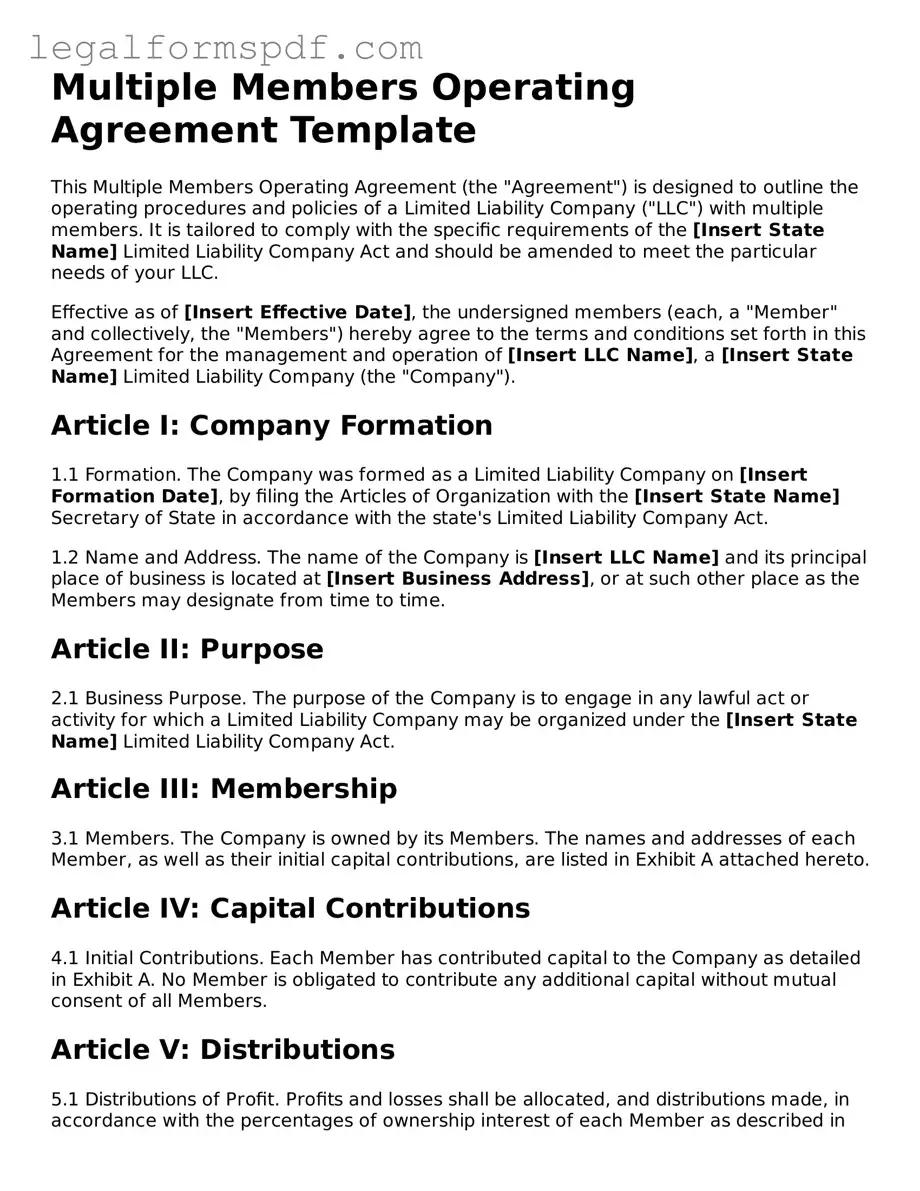Multiple Members Operating Agreement Template
This Multiple Members Operating Agreement (the "Agreement") is designed to outline the operating procedures and policies of a Limited Liability Company ("LLC") with multiple members. It is tailored to comply with the specific requirements of the [Insert State Name] Limited Liability Company Act and should be amended to meet the particular needs of your LLC.
Effective as of [Insert Effective Date], the undersigned members (each, a "Member" and collectively, the "Members") hereby agree to the terms and conditions set forth in this Agreement for the management and operation of [Insert LLC Name], a [Insert State Name] Limited Liability Company (the "Company").
Article I: Company Formation
1.1 Formation. The Company was formed as a Limited Liability Company on [Insert Formation Date], by filing the Articles of Organization with the [Insert State Name] Secretary of State in accordance with the state's Limited Liability Company Act.
1.2 Name and Address. The name of the Company is [Insert LLC Name] and its principal place of business is located at [Insert Business Address], or at such other place as the Members may designate from time to time.
Article II: Purpose
2.1 Business Purpose. The purpose of the Company is to engage in any lawful act or activity for which a Limited Liability Company may be organized under the [Insert State Name] Limited Liability Company Act.
Article III: Membership
3.1 Members. The Company is owned by its Members. The names and addresses of each Member, as well as their initial capital contributions, are listed in Exhibit A attached hereto.
Article IV: Capital Contributions
4.1 Initial Contributions. Each Member has contributed capital to the Company as detailed in Exhibit A. No Member is obligated to contribute any additional capital without mutual consent of all Members.
Article V: Distributions
5.1 Distributions of Profit. Profits and losses shall be allocated, and distributions made, in accordance with the percentages of ownership interest of each Member as described in Exhibit A, subject to adjustments as Members may agree in writing.
Article VI: Management
6.1 Management of the Company. The Company shall be managed by its Members. Each Member shall have authority and control over Company business as agreed upon by all Members and outlined in this Agreement.
Article VII: Voting
7.1 Voting Rights. Each Member shall have voting rights in proportion to their ownership interest. Decisions requiring a vote shall be made by a majority of the voting interest of the Members, except as otherwise required by law or specified in this Agreement.
Article VIII: Bookkeeping
8.1 Records. Accurate and complete records of the Company's business transactions will be maintained at the Company's principal place of business. All Members shall have access to these records upon reasonable request.
Article IX: Amendments
9.1 Amendments. This Agreement can only be amended by written consent of all the Members.
Article X: Dissolution
10.1 Dissolution. The Company may be dissolved with the consent of Members owning a majority of the Company's membership interest, or as otherwise provided by [Insert State Name] law.
Article XI: Governing Law
11.1 Governing Law. This Agreement and the rights of the Members shall be governed by and interpreted in accordance with the laws of the State of [Insert State Name], without regard to its conflict of laws principles.
IN WITNESS WHEREOF, the Members have executed this Multiple Members Operating Agreement as of the last date written below:
Member Signature: __________________________________ Date: _______________
Member Signature: __________________________________ Date: _______________
(Add additional signature lines as necessary)
Exhibit A: Members and Capital Contributions
- Member Name: _______________ Capital Contribution: _______________
- Member Name: _______________ Capital Contribution: _______________
- (Add additional lines as necessary)
